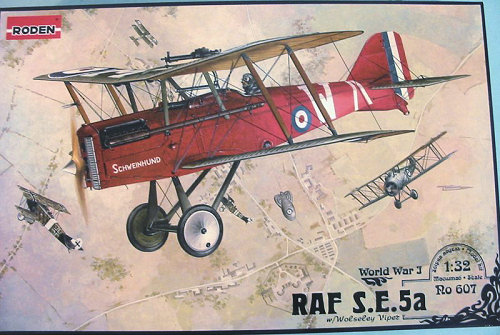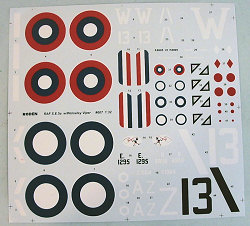
| KIT: | Roden 1/32 S.E.5a (Wolsey-Viper) |
| KIT #: | 607 |
| PRICE: | $64.99 MSRP |
| DECALS: | Five options |
| REVIEWER: | Tom Cleaver |
| NOTES: | New Mold |

| HISTORY |
If the Sopwith Camel was the "Spitfire" of the First World War, the Royal Aircraft Factory's S.E.5a was the "Hurricane" of that conflict. Two more different responses to the same need could not be imagined, other than that of the Spitfire and Hurricane. While the delicate Camel was tricky and temperamental, and ofttimes dangerous to the less‑experienced of its pilots, the rugged S.E.5a was stable and predictable.
H.P. Folland, the Chief Designer of the Royal Aircraft Factory, had been working through several "Scout, Experimental" designs, all of which were far more influenced by the German Albatros than they were by the French Nieuport ‑ the two fighters of the first part of the war that set the two different standards of fighter type aircraft, one solid and speedy, the other light and highly maneuverable. Folland went on after the war, as Chief Designer of the Gloucestershire Aircraft Company (shortened soon to Gloster) to design all the fighters used by the RAF that were not designed by Sidney Camm at Hawkers, and ended his career in the 1950s with the Folland Gnat, his answer to the size‑and‑weight spiral of the jet fighter, and a serious attempt to return to the kind of fighter he had designed at the outset of his career.
The S.E.5, which began to appear in the squadrons on the Western Front in the Spring of 1917, was at first unsuccessful. Powered by the 180 h.p. Hispano‑Suiza, it basically didn't have enough get‑up‑and‑go to meet the Albatros on an equal if not superior footing. Re‑engined with the 200 h.p. geared Hispano and redesignated S.E.5a, the airplane found greater acceptance that summer in the hands of such aces as James McCudden, Billy Bishop, and Mick Mannock, to name but a few. That September, pilots of 56 Squadron, under the leadership of McCudden, fought an epic battle with a single Fokker triplane flown by Werner Voss; though the Fokker could literally fly rings around the S.E.5a, not even Voss could outfly eight other aces at once, and it proved to be his final battle.
The S.E.5a finally received a successful powerplant when Wolsey - who were producing the 200 h.p. geared Hispano‑Suiza - modified it to a direct‑drive 200 h.p. engine that was known as the Wolseley Viper, which solved all the reliability problems of the Hispano. The Viper was used on the majority of the aircraft produced in 1918, and replaced the Hispanos in earlier S.E.5a’s when they were due for engine changes. Without the torque‑inducing rotary of the Camel, and with a high degree of dihedral in the design, the S.E.5a was never the dogfighter the Camel was, but it was a more stable gun platform. By 1918, most successful aces had realized that a “drive by” ambush of the unwary, with a high-speed getaway, was preferable to the unpredictability of a dogfight, so a fighter that could dive under good control and allow for a well‑aimed burst provided many British pilots with an increase in their scores. The same was true of the French SPAD, which shared many similar characteristics with the S.E.5a as regards ruggedness.
The S.E.5a also served in Mesopotamia, Palestine and Macedonia during the war, with the air forces of Great Britain, Australia and the United States, where it was used by both the United States Army and Navy. The majority of the top-scoring aces of the RAF flew the S.E.5a, which is perhaps the best recommendation for the airplane.
| THE KIT |
 I have long thought that 1/32 is the ideal scale for World War One models, since
the result will not be a really large model, while the size is sufficient to
provide more visible detail than would be possible in 1/48 or 1/72 scales.
Roden has demonstrated this with their release of the Fokker Triplane and
Albatros D.III, and this S.E.5a continues that.
I have long thought that 1/32 is the ideal scale for World War One models, since
the result will not be a really large model, while the size is sufficient to
provide more visible detail than would be possible in 1/48 or 1/72 scales.
Roden has demonstrated this with their release of the Fokker Triplane and
Albatros D.III, and this S.E.5a continues that.
The kit comes on five sprues in Roden’s now-standard light tan plastic. The
wings and tail surfaces are very
thin as they should be, with Roden’s very effective fabric detail. This also
extends to the fuselage, where there is a very subtle “dishing” of the fabric
along the fuselage side over the internal structure.
are very
thin as they should be, with Roden’s very effective fabric detail. This also
extends to the fuselage, where there is a very subtle “dishing” of the fabric
along the fuselage side over the internal structure.
The kit is essentially the 1/48 kit scaled up. This is good in that the 1/48 kit is the most accurate S.E.5a available. The bad part is that there is no additional detail beyond the 1/48 kit in such areas as the cockpit. This is not as big a problem as it might be with the Fokker Triplane, since the S.E.5a had a very simple cockpit; taking the time to create a varnished wood effect in the cockpit will go far to solving this. Eduard makes a very nice early Sutton harness in 1/32 scale, which is correct for the S.E.5a and will result in an improved look to the cockpit.
Decals are provided for four top Commonwealth aces: Mick Mannock, Billy Bishop, Arthur Beauchamp-Proctor, and Duncan Grinnell-Milne, and an American S.E.5a flown by the 25th Aero Squadron, U.S.A.S.
| CONCLUSIONS |
This kit looks to be relatively easy to assemble for a biplane model. The S.E.5a has enough rigging that it qualifies as at least a “semi-birdcage,” so it is not for the beginning biplane modeler. That said, a World War One modeler with a few kits completed should have no serious problem with this kit, while a more advanced modeler has the necessary raw material to create a really detailed model of this famous fighter.
June 2007
If you would like your product reviewed fairly and quickly by a site that has over 350,000 visitors a month, please contact me or see other details in the Note to Contributors.